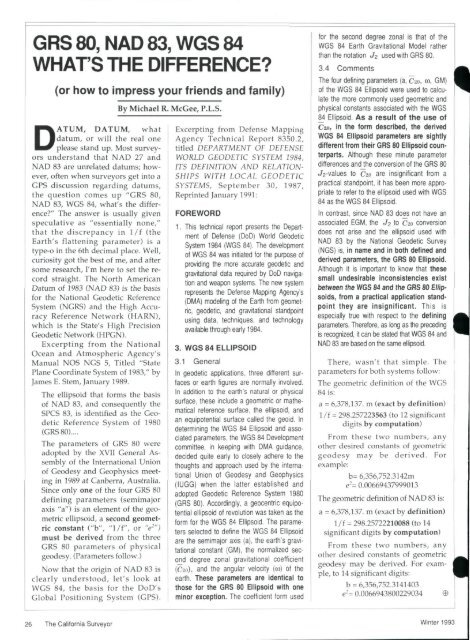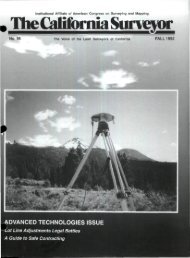t The California Surveyor - CLSA
t The California Surveyor - CLSA
t The California Surveyor - CLSA
You also want an ePaper? Increase the reach of your titles
YUMPU automatically turns print PDFs into web optimized ePapers that Google loves.
GRS 80, NAD 83, WGS 84<br />
WHAT'S THE DIFFERENCE?<br />
(or how to impress your friends and family)<br />
DATUM, DATUM, what<br />
datum, or will the real one<br />
please stand up. Most surveyors<br />
understand that NAD 27 and<br />
NAD 83 are unrelated datums; however,<br />
often when surveyors get into a<br />
GPS discussion regarding datums,<br />
the question comes up "GRS 80,<br />
NAD 83, WGS 84, what's the difference?"<br />
<strong>The</strong> answer is usually given<br />
speculative as "essentially none,"<br />
that the discrepancy in 1/f (the<br />
Earth's flattening parameter) is a<br />
type-o in the 6th decimal place. Well,<br />
curiosity got the best of me, and after<br />
some research, I'm here to set the record<br />
straight. <strong>The</strong> North American<br />
Datum of 1983 (NAD 83) is the basis<br />
for the National Geodetic Reference<br />
System (NGRS) and the High Accuracy<br />
Reference Network (HARN),<br />
which is the State's High Precision<br />
Geodetic Network (HPGN).<br />
Excerpting from the National<br />
Ocean and Atmospheric Agency's<br />
Manual NOS NGS 5, Titled "State<br />
Plane Coordinate System of 1983," by<br />
James E. Stem, January 1989.<br />
<strong>The</strong> ellipsoid that forms the basis<br />
of NAD 83, and consequently the<br />
SPCS 83, is identified as the Geodetic<br />
Reference System of 1980<br />
(GRS 80)....<br />
<strong>The</strong> parameters of GRS 80 were<br />
adopted by the XVII General Assembly<br />
of the International Union<br />
of Geodesy and Geophysics meeting<br />
in 1989 at Canberra, Australia.<br />
Since only one of the four GRS 80<br />
defining parameters (semimajor<br />
axis "a") is an element of the geometric<br />
ellipsoid, a second geometric<br />
constant ("b", "1/f", or "e 2 ")<br />
must be derived from the three<br />
GRS 80 parameters of physical<br />
geodesy. (Parameters follow.)<br />
Now that the origin of NAD 83 is<br />
clearly understood, let's look at<br />
WGS 84, the basis for the DoD's<br />
Global Positioning System (GPS).<br />
By Michael R. McGee, P.L.S.<br />
Excerpting from Defense Mapping<br />
Agency Technical Report 8350.2,<br />
titled DEPARTMENT OF DEFENSE<br />
WORLD GEODETIC SYSTEM 1984,<br />
ITS DEFINITION AND RELATION<br />
SHIPS WITH LOCAL GEODETIC<br />
SYSTEMS, September 30, 1987,<br />
Reprinted January 1991:<br />
FOREWORD<br />
1. This technical report presents the Department<br />
of Defense (DoD) World Geodetic<br />
System 1984 (WGS 84). <strong>The</strong> development<br />
of WGS 84 was initiated for the purpose of<br />
providing the more accurate geodetic and<br />
gravitational data required by DoD navigation<br />
and weapon systems. <strong>The</strong> new system<br />
represents the Defense Mapping Agency's<br />
(DMA) modeling of the Earth from geometric,<br />
geodetic, and gravitational standpoint<br />
using data, techniques, and technology<br />
available through early 1984.<br />
3. WGS 84 ELLIPSOID<br />
3.1 General<br />
In geodetic applications, three different surfaces<br />
or earth figures are normally involved.<br />
In addition to the earth's natural or physical<br />
surface, these include a geometric or mathematical<br />
reference surface, the ellipsoid, and<br />
an equipotential surface called the geoid. In<br />
determining the WGS 84 Ellipsoid and associated<br />
parameters, the WGS 84 Development<br />
committee, in keeping with DMA guidance,<br />
decided quite early to closely adhere to the<br />
thoughts and approach used by the international<br />
Union of Geodesy and Geophysics<br />
(IUGG) when the latter established and<br />
adopted Geodetic Reference System 1980<br />
(GRS 80). Accordingly, a geocentric equipotential<br />
ellipsoid of revolution was taken as the<br />
form for the WGS 84 Ellipsoid. <strong>The</strong> parameters<br />
selected to define the WGS 84 Ellipsoid<br />
are the semimajor axis (a), the earth's gravitational<br />
constant (GM), the normalized second<br />
degree zonal gravitational coefficient<br />
(CM), and the angular velocity (w) of the<br />
earth. <strong>The</strong>se parameters are identical to<br />
those for the GRS 80 Ellipsoid with one<br />
minor exception. <strong>The</strong> coefficient form used<br />
for the second degree zonal is that of the<br />
WGS 84 Earth Gravitational Model rather<br />
than the notation J 2 used with GRS 80.<br />
3.4 Comments<br />
<strong>The</strong> four defining parameters (a, Czo, co, GM)<br />
of the WGS 84 Ellipsoid were used to calculate<br />
the more commonly used geometric and<br />
physical constants associated with the WGS<br />
84 Ellipsoid. As a result of the use of<br />
Czo, in the form described, the derived<br />
WGS 84 Ellipsoid parameters are sightly<br />
different from their GRS 80 Ellipsoid counterparts.<br />
Although these minute parameter<br />
differences and_t_he conversion of the GRS 80<br />
^-values to Czo are insignificant from a<br />
practical standpoint, it has been more appropriate<br />
to refer to the ellipsoid used with WGS<br />
84 as the WGS 84 Ellipsoid.<br />
In contrast, since NAD 83 does not have an<br />
associated EGM, the Jz to Czo conversion<br />
does not arise and the ellipsoid used with<br />
NAD 83 by the National Geodetic Survey<br />
(NGS) is, in name and in both defined and<br />
derived parameters, the GRS 80 Ellipsoid.<br />
Although it is important to know that these<br />
small undesirable inconsistencies exist<br />
between the WGS 84 and the GRS 80 Ellipsoids,<br />
from a practical application standpoint<br />
they are insignificant. This is<br />
especially true with respect to the defining<br />
parameters. <strong>The</strong>refore, as long as the preceding<br />
is recognized, it can be stated that WGS 84 and<br />
NAD 83 are based on the same ellipsoid.<br />
<strong>The</strong>re, wasn't that simple. <strong>The</strong><br />
parameters for both systems follow:<br />
<strong>The</strong> geometric definition of the WGS<br />
84 is:<br />
a = 6,378,137. m (exact by definition)<br />
1/f = 298.257223563 (to 12 significant<br />
digits by computation)<br />
From these two numbers, any<br />
other desired constants of geometric<br />
geodesy may be derived. For<br />
example:<br />
b= 6,356,752.3142m<br />
e 2 = 0.00669437999013<br />
<strong>The</strong> geometric definition of NAD 83 is:<br />
a = 6,378,137. m (exact by definition)<br />
1/f = 298.25722210088 (to 14<br />
significant digits by computation)<br />
From these two numbers, any<br />
other desired constants of geometric<br />
geodesy may be derived. For example,<br />
to 14 significant digits:<br />
b = 6,356,752.3141403<br />
e 2 = 0.0066943800229034 0<br />
26 <strong>The</strong> <strong>California</strong> <strong>Surveyor</strong> Winter 1993

















